Taxpayers will need to support Scottish agriculture to the same level as the CAP does in order to achieve the environmental benefits required by society.
That is one of the conclusions of the long-awaited CAP Greening Review Group report which has been published by the Scottish Government.
The report, which has taken a year to produce, looked at how future policy and support mechanisms could benefit environmentally and economically sustainable farming, and it appears to chime with recent statements by Defra Secretary Michael Gove who envisages farmers being supported by public money for public goods.
It was produced under the chairmanship of Professor Russel Griggs, and concludes that future environmental support options need to be better targeted than the current system in order to deliver positive outcomes for farmers and the environment.
It states: “It is envisaged that all payments would be associated with outcomes that deliver public good.
“In return for payments, farmers would have to undertake specific land management activities or meet certain requirements.”
Most significantly it points out the current “one size fits all” solution is not the best way to proceed and states that activities and requirements will need to be targeted to different farm types and geographic locations – although some universal requirements could also apply.
However it envisages all farmland, both in the uplands and the lowlands, being eligible for payments.
Two tiers of payments have been considered by the review group, with an “entry level” and a “higher level”.
The entry level would be open to all farmers and farmland and have the broad aim of protecting soil, air and water resources, reducing greenhouse gas emissions and maintaining farmland habitats and features important for wildlife such as hedgerows and winter stubbles.
This level should be made simple for farmers to access and for Government to administer.
A higher tier would contain more targeted or bespoke options offered by groups or sectors who have a “greater level of environmental ambition”. Accessing payments under this tier could be competitive.
The group also promotes the idea of cooperative or catchment-scale approaches to delivering environmental outcomes and has recommended that mechanisms to encourage greater cooperation and collaboration between farmers in Scotland should be included in any future policy framework.
Regulation also features in the review, and while it acknowledges that
monitoring will be required to safeguard public spending, farmers will be relieved to learn that it “must be done in a way that applies risk and common sense – and where necessary flexibility – to allow enhancements or adaption that fit circumstances better than the current system.”
nnicolson@thecourier.co.uk







